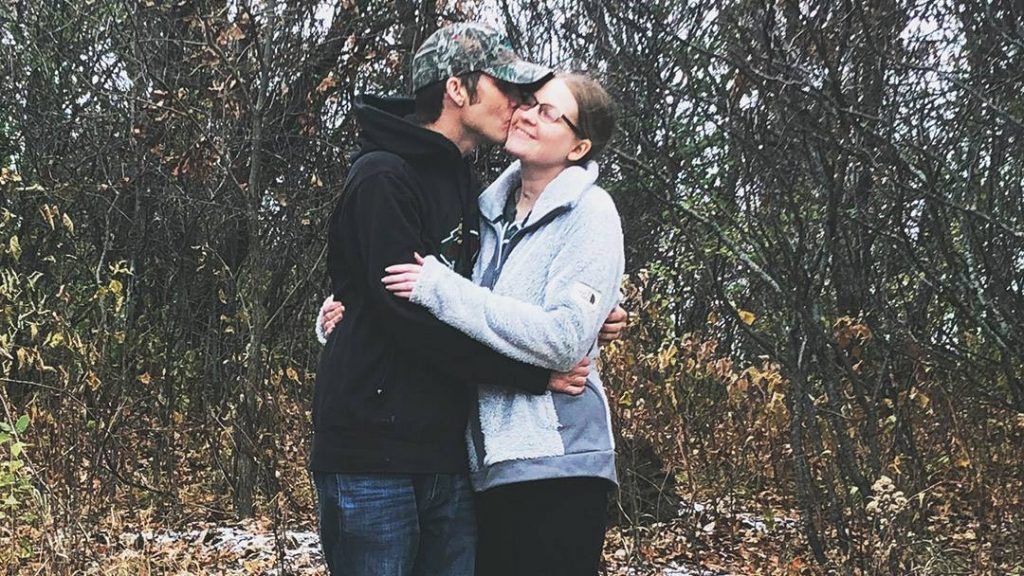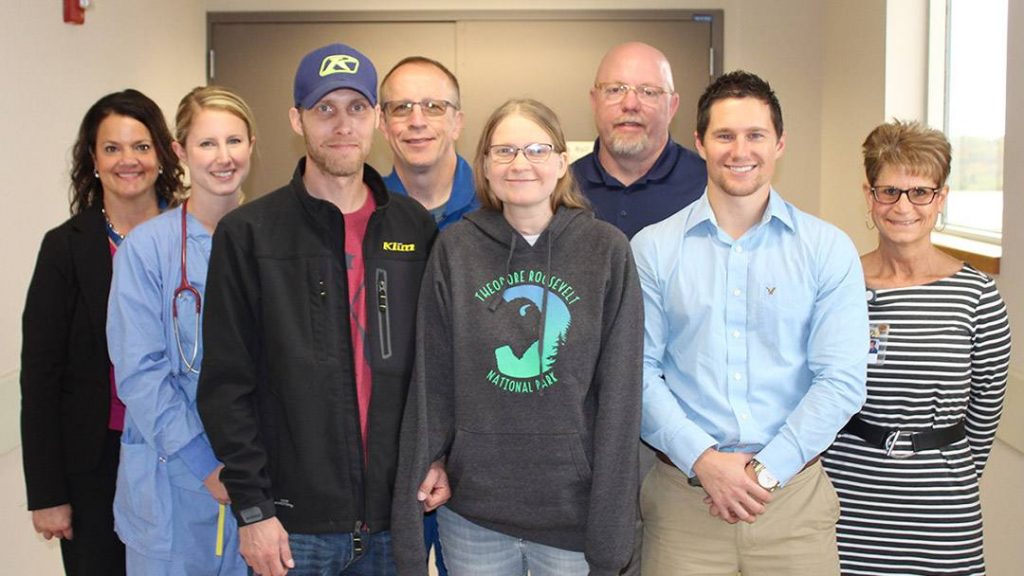-
Sharing Mayo Clinic: “They told me that she was as sick as she could possibly get.”

Tabetha and Matt Cameron live a quiet life. Partners since their teens, the Camerons spend their days enjoying familiar activities close to their northern Minnesota home. The couple cherishes their tranquil existence, especially since Tabetha underwent a harrowing medical trauma that nearly took her life.
On May 19, after Matt Cameron said goodbye to his wife, Tabetha, and she was whisked away by a Mayo Clinic air ambulance medical team, he wasn't sure if he'd see her alive again.
In the preceding hours, his wife of 12 years had suffered a complete physical breakdown, going from feeling flu-like symptoms to developing sepsis — a life-threatening condition that causes multiorgan failure. "I honestly didn't think she was going to make it," Matt says. "They told me that she was as sick as she could possibly get."
Tabetha's lungs had stopped oxygenating her blood. Lacking oxygen, her liver and heart stopped working. The only way to keep Tabetha alive was through a process called extracorporeal membrane oxygenation, or ECMO. That was a problem for Tabetha and her care team at Altru Health System in Grand Forks, North Dakota — a member of the Mayo Clinic Care Network. The hospital had a surgeon who could start the treatment for Tabetha. But it lacked resources to sustain the therapy, which involves shuttling blood from the body via large tubes, called cannulas, into a machine that adds oxygen to the blood and then returns it to the body.
Altru administrators contacted Mayo Clinic. Within minutes, a conference call convened that involved clinicians from Mayo's Admission and Transfer Center, Mayo Clinic Ambulance Service — Air Operations, receiving providers from Mayo Clinic, and the team at Altru. Together, they made a decision that gave Tabetha a chance at recovery.
"Thankfully the providers agreed to put her on ECMO," says Meghan Lamp, a Mayo Clinic Ambulance Service air transport coordinator. "We could take that function away from her body system and do it mechanically for her to keep her alive."
With precision care provided by the Tabetha's Mayo Clinic Ambulance Service team and a virtual army of specialists who cared for her upon arrival at Mayo Clinic in Rochester, Tabetha not only survived the ambulance ride, but she was able to weather a months-long hospitalization and a lengthy rehabilitation.
"I wasn't very hopeful. It was hard to see a good outcome," Matt says. "I would have never imagined that she'd be sitting here next to me doing as well as she is right now."
High-stakes medical flight
It might never be known what triggered the infection that led to sepsis and nearly cost Tabetha her life. But what is known is that recovery would have been impossible without strategic coordination and careful planning throughout her ordeal, says Jonathan Fox, M.D., one of the Critical Care specialists who cared for Tabetha during the nearly four weeks she spent in intensive care at Mayo Clinic.
"All of the patients that we see, what they are undergoing is far too complicated for any one person to be able to provide adequate care for them," Dr. Fox says. "We do it as a team. If we didn't have all those people, there's no way our patients would do as well as they do."
Careful orchestration of care was crucial during the two hours Tabetha spent in transit between Grand Forks and Rochester. Because people connected to ECMO are the highest-risk patients to transfer, precision planning is essential, says Matthew Schuldes, a transport team perfusionist. Schuldes was in charge of switching Tabetha's ECMO connections from those at Altru to Mayo Clinic's equipment. He also oversaw the therapy during her transport.
"There is a lot of risk in transporting these patients because once you're in the air, you don't have access to a ton of emergency supplies if you would need them quickly," Schuldes says.
"There are lots of things to manage. It's kind of normal for us, but it's not normal for most people who don't take care of these patients all the time."
Matthew Schuldes
Another concern for the team was managing the large number of connections to tubes and wires tethering Tabetha to machines, medicine and monitors. "Every part of her had a tube going in and out," Schuldes says. "There are lots of things to manage. It's kind of normal for us, but it's not normal for most people who don't take care of these patients all the time."
Two large cannulas going to and from veins in Tabetha's groin area were of particular concern to Schuldes, he says. "Those are the ones I worry about the most because there are severe consequences if they become dislodged."
Transport teams typically average about 30 minutes in hospitals retrieving patients. But complex cases like Tabetha's require more time. They involve a collaborative, methodical approach by the entire transport team of nurses, paramedics, respiratory therapists and perfusionists to ensure each piece of equipment is positioned and moved in a coordinated way that ensures patients remain stable and don't experience catastrophic changes, says Kelly Sahs, Mayo Clinic Ambulance Service air transport clinical operations director, who was involved with Tabetha's transport.
Collaborative, coordinated care
For Tabetha, the safe trip to Mayo Clinic Hospital — Rochester, Saint Marys Campus was the first leg of a marathon treatment journey that involved support from critical care specialists, cardiologists, pulmonologists, nephrologists, nurses, rehabilitation therapists and many other providers. During the initial days of Tabetha's hospitalization, her condition was stabilized in the Cardiac ICU while she remained on ECMO. As she improved, her team explored the idea of weaning her from ECMO, but they soon realized there was a heart complication.
"We found there was a problem with her aortic valve and ascending aorta, with a blood clot very close to the aortic valve," says M. Sertac Cicek, M.D., a Mayo Clinic cardiovascular surgeon. "We decided not to take the ECMO support off and that she needed extra testing to evaluate what was going on with her aorta."
Tests confirmed there was not only a blood clot next to Tabetha's heart, but a portion of the aorta adjacent to her heart had developed a bulge, or aneurysm, and that required surgery. "We had to replace that part of the aortic root," Dr. Cicek says. "We had to replace the aortic valve and had to replace the ascending aorta completely."

Tabetha's recovery from her surgery on May 24 was tenuous. Bleeding, irregular heart rhythms and excess fluid required her chest be reopened and for her to return to ECMO support temporarily. Several days after the surgery, Tabetha was weaned from ECMO, but she needed a tracheostomy to provide stronger breathing support. During this time, she also required dialysis because her kidneys stopped working.
Through the many weeks in the ICU, Matt kept vigil at Tabetha's side. "I just couldn't leave," he says. As awful as the experience was, Matt found reassurance in the constant presence of Tabetha's care team, who worked around the clock to manage his wife's many complications.
"Most everybody was just as a nice as could be," Matt says. "Looking back now, there was one doctor, Dr. Fox — and I don't know if he was saying it to make me feel better — but he was like: 'Everything is going to be all right. She probably is going to be here for a couple of months, but you guys are going to get through this.' That seemed to help. He had so much confidence."
Offering mental and emotional support to families is just as important as the medical help provided to patients, Dr. Fox says. "I don't think many people have any inkling of how difficult it is for family members and loved ones to be there as they watch their loved ones try to recover," Dr. Fox says. "As medical professionals, there's only so much we can do for people under our care. Many times, we spend as much time helping the families out, helping them to understand what is going on, what they can expect, and simply listening to them and to their concerns."
Gradual, gratitude-filled recovery
Tabetha remained in the Cardiac ICU until mid-June. From there, she moved to a cardiac rehabilitation unit, where she stayed for another week. After that, Tabetha was transferred to a non-Mayo facility for respiratory therapy to prepare for the tracheostomy to be removed. But Tabetha developed pneumonia and was transferred back to Mayo Clinic.
Tabetha stayed in the hospital for another week before the she was healthy enough for the tracheostomy removal. A few days after that, Tabetha was discharged, and she returned to her home in Thief River Falls, Minnesota.
Although Tabetha remembers little about what happened during her medical odyssey before she was in the cardiac rehabilitation unit, when she thinks about the experience, she still feels fear. "She told me that she had a lot of nightmares," Matt says. "It pretty much seemed to her the whole time she was out was like a big, long nightmare."
After such a traumatic, life-threatening ordeal, the couple spent the rest of the summer on easy, familiar activities, like camping and a daytrip to a national park. "I've tried to keep things as normal as possible," Matt says. He adds that with each day that passes, Tabetha gains a little more strength. "She does a little more here and there, and by the week, she seems to be getting better."
"I feel very lucky that I had the care I did. They say not many people recover from this, and I feel like I got a second chance."
Tabetha Cameron
For Tabetha and Matt, events that used to be routine or familiar now have greater meaning. "I feel very lucky that I had the care I did," Tabetha says. "They say not many people recover from this, and I feel like I got a second chance."
For Matt, whose time at Tabetha's bedside exposed him to situations that ended differently than his wife's, the gratitude he feels toward those who enabled Tabetha's recovery is profound.
"I met a lot of people in similar situations to what I was in, and theirs did not work out as good as mine in every case, so we're really lucky," Matt says. "Without Mayo, I don't think we'd have the same outcome."
HELPFUL LINKS
- Read more about Mayo Clinic Ambulance Service.
- Check out the departments of Critical Care and Cardiovascular Surgery.
- Learn about Mayo Clinic Care Network.
- Explore Mayo Clinic.
- Request an appointment.
Related Articles






